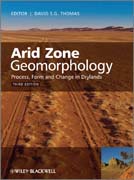
The new edition of Arid Zone Geomorphology aims to encapsulate the advances that have been made in recent years in the investigation and explanation of landforms and geomorphological processes in drylands. Building on the success ofthe previous two editions, the Third Edition has been completely revised and updated to reflect the latest developments in the field. Whilst this latest edition will remain a comprehensive reference to the subject, the book has been restructured to include regional case studies throughout to enhance student understanding and is clearly defined into five distinct sections; Firstly, the book introduces the reader to Large Scale Controls and Variability in Drylands and then moves on to consider Surface Processes and Characteristics; The Work of Water, The Work of the Wind. The book concludes with a section on Living with Dryland Geomorphology that includes a chapter on geomorphological hazards and the human impact on these environments. Once again, recognised world experts in the field have been invited to contribute chapters in order to present a comprehensive and up-to-date overview of current knowledge about the processesshaping the landscape of deserts and arid regions. In order to broaden the appeal of the Third Edition, the book has been reduced in extent by 100 pages and the Regional chapters have been omitted in favour of the inclusion of key regional case studies throughout the book. The Editor is also considering the inclusion of a supplementary website that could include further images, problemsand case studies. INDICE: List of contributors. Preface to the first edition. Preface to the second edition. Preface to the third edition. I Large-scale controls and variability in drylands. 1 Arid environments: their nature and extent (David S.G. Thomas). 1.1 Geomorphology in arid environments. 1.2 Arid zone distinctiveness and the quest for explanation. 1.3 Arid zones: terminology and definitions.1.4 The age of aridity on Earth. 1.5 The distribution of arid zones. 1.6 Causes of aridity. 1.7 Climate variability. 1.8 Dryland ecosystems. 1.9 Arid zone geomorphology and people. 1.10 Organisation of this book. 2 Tectonic frameworks (Helen Rendell). 2.1 Introduction. 2.2 Tectonic setting of drylands. 2.3 Uplift and erosion, subsidence and sedimentation. 2.4 Lengths of record. 2.5 Existing erosional and depositional records in arid environments. 2.6 Selected examples of the geomorphological impact of active tectonics in arid environments.2.7 Conclusions. 3 Climatic frameworks: legacies from the past (David S.G. Thomas and Sallie L. Burrough). 3.1 Introduction. 3.2 The significance of arid zone fluctuations in the past. 3.3 Dating arid zone fluctuations. 3.4 Climatic interpretations and issues. 3.5 Conclusions. 4 Dryland system variability (David S. G. Thomas). 4.1 A framework for dryland diversity. 4.2 Geomonotony: how unvarying are the 'flat' drylands of the world? 4.3 Within-dryland diversity. 4.4 Summary issues. 5 Extraterrestrial arid surface processes (Jonathan Clarke). 5.1 Introduction. 5.2 What does 'aridity' mean beyond Earth? 5.3 Why shouldplanetary scientists understand terrestrial arid geomorphology? 5.4 What can terrestrial geomorphologists learn from a solar system perspective? 5.5 Mars: water-based aridity. 5.6 Titan: methane-based aridity? 5.7 Venus: extreme aridity. 5.8 Future Directions. II Surface processes and characteristics. 6 Weathering systems (Heather A. Viles). 6.1 Introduction. 6.2 What makes arid environments unusual in terms of weathering systems? 6.3 Theoretical underpinnings ofweathering systems research. 6.4 Current weathering study methods. 6.5 Linking processes to form in arid weathering systems. 6.6 Explaining the developmentof weathering landforms in arid environments. 6.7 Weathering rates in arid environments. 6.8 Arid weathering and landscape evolution. 6.9 Scale and arid weathering systems. 7 Desert soils (David L. Dunkerley). 7.1 Introduction: the nature and significance of desert soils. 7.2 Taxonomy of desert soils. 7.3 Somedistinctive aspects of desert soil development. 7.4 Stone-mantled surfaces and desert pavements. 7.5 Inorganic seals at the soil surface. 7.6 Vesicular soil structures. 7.7 Conclusions. 8 Desert crusts and rock coatings (David J. Nash). 8.1 Introduction. 8.2 Sodium nitrate deposits. 8.3 Halite crusts. 8.4 Gypsum crusts. 8.5 Calcrete. 8.6 Silcrete. 8.7 Desert rock coatings. 8.8 Palaeoenvironmental significance of crusts. 9 Pavements and stone mantles (Julie E. Laity). 9.1 Introduction. 9.2 Surface types: hamadas and stony surfaces. 9.3 General theories concerning stony surface formation. 9.4 Stone pavement characteristics. 9.5 Processes of pavement formation. 9.6 Processes of clast size reduction in pavements. 9.7 Secondary characteristics
- ISBN: 978-0-470-51909-7
- Editorial: John Wiley & Sons
- Encuadernacion: Rústica
- Páginas: 648
- Fecha Publicación: 01/02/2011
- Nº Volúmenes: 1
- Idioma: Inglés
